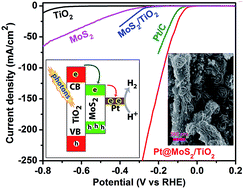Strongly enhanced visible light photoelectrocatalytic hydrogen evolution reaction in an n-doped MoS2 /TiO2(B) heterojunction by selective decoration of platinum nanoparticles at the MoS2 edge sites†
Abstract
Herein, we demonstrate strongly enhanced visible light photoelectrocatalytic hydrogen evolution reaction (HER) in few-layer MoS2 grown on a mesoporous TiO2(B) nanobelt (NB) by selective decoration of platinum (Pt) nanoparticles (NPs) on the edge/defect sites of the MoS2 layer. Three catalytically active components are anchored together to increase the photoelectrocatalytic HER activity synergistically, beyond that of commercial Pt/C electrodes (20 wt% Pt). An extremely low concentration of Pt NPs (1.4 wt%) with average size ∼3.8 nm was decorated over the preferentially edge-site-exposed few-layer MoS2, with lateral sizes 130–350 nm, as evidenced from high-angle annular dark-field STEM imaging. During the heterojunction formation, S is doped in the TiO2 layer causing a high density of electrons in TiO2 that migrate to the MoS2 layer inducing n-type doping in it and thus TiO2 acts as an efficient photocathode in photoelectrocatalysis. Quantitative XPS analysis reveals that the catalytically active bridging S22−/apical S2− increases up to ∼72% after the formation of the ternary system Pt@MoS2/TiO2(B). S-enriched MoS2/TiO2(B) selectively loaded with Pt NPs on the edge sites of MoS2 exhibits a giant enhancement in the HER activity in an acidic medium under light. We record a nearly 16 fold higher exchange current density (0.296 mA cm−2) for the ternary system as compared to that of the MoS2/TiO2 binary system under visible light excitation. The marginally Pt loaded ternary system exhibits an extremely low charge transfer resistance (14 Ω) and a low overpotential as well as Tafel slope (−74 mV and 30 mV dec−1, respectively) boosting the overall HER performance under visible light. Chronopotentiometric measurements reveal the high stability of binary and ternary systems to sustain a 10 mA cm−2 cathodic current up to 12 hours. The results show that the marginally loaded Pt NPs activate the inert basal plane, edge sites of MoS2 and porous sites of TiO2, forming an integrated network where the photogenerated electrons can easily be injected from the TiO2 to MoS2 and then to Pt NPs, presenting a feasible approach to boost the HER activity under visible light.



 Please wait while we load your content...
Please wait while we load your content...